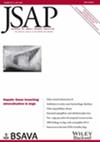Epidemiology of Angiostrongylus vasorum and Crenosoma vulpis infection in dogs in Denmark
Abstract
Objectives
This retrospective study aimed to evaluate the risk factors (age and breed group) associated with Angiostrongylus vasorum and Crenosoma vulpis infection in dogs.
Materials and Methods
Faecal examinations obtained in dogs from January 2016 to December 2021 as part of routine clinical practice at two veterinary clinics in the Odsherred region of Zealand, Denmark, were included in this study. Faecal samples were analysed using the Baermann technique for nematode detection. Samples were collected from two clinics located in Northwestern Zealand, Denmark. Multinomial regression analysis, quasi-Poisson models and a generalised additive model for linearity were used to analyse the data.
Results
A total of 2,013 faecal samples were included in the study. Age was a significant risk factor for a positive Baermann, with a negative linear relationship observed (A. vasorum odds ratio: 0.80, 95% confidence interval: 0.70 to 0.91, C. vulpis odds ratio: 0.95, 95% confidence interval: 0.91 to 0.99, both nematodes: odds ratio: 0.87, 95% confidence interval: 0.77 to 0.99). Breed group analysis considering retrievers and flushing and water dog as reference group, demonstrated that sheep- and cattle dogs had a reduced risk of C. vulpis infection (odds ratio: 0.49, 95% confidence interval: 0.24 to 0.97), whereas dachshunds had an increased risk of A. vasorum infection (odds ratio: 3.28, 95% confidence interval: 1.14 to 9.47). Variations in the number of nematodes was found, with companion and toy dogs exhibiting higher numbers of C. vulpis (incidence rate ratio: 21.40, 95% confidence interval: 2.88 to 159) and sheep- and cattle dogs displaying higher numbers of A. vasorum (incidence rate ratio: 30.20, 95% confidence interval: 7.33 to 125). The prevalence rates of C. vulpis and A. vasorum were estimated at 14.50% (95% confidence interval: 13 to 16.10) and 3.40% (95% confidence interval: 2.70 to 4.30), respectively.
Clinical Significance
There are significant risk factors for nematode infection in dogs that can be considered for proper preventive care of this condition.

 求助内容:
求助内容: 应助结果提醒方式:
应助结果提醒方式:


